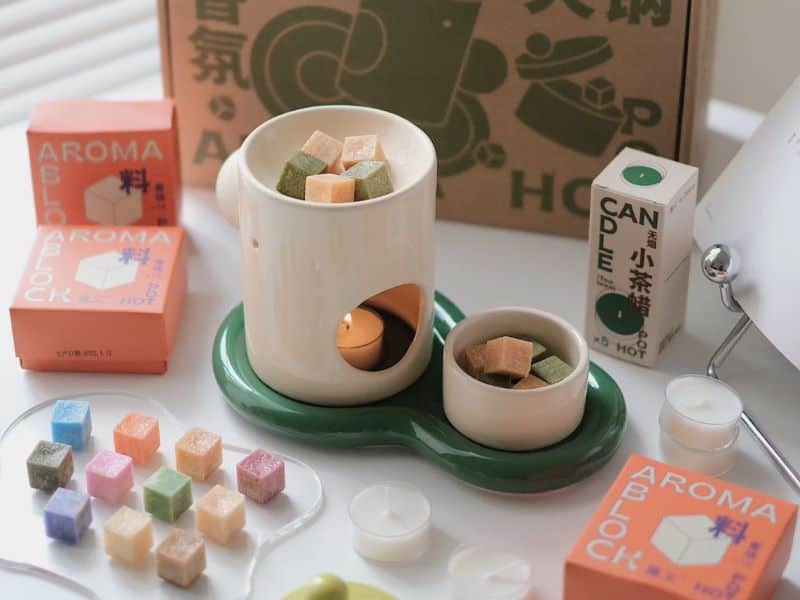Have you ever lit a scented candle that smelled so good that you wanted to eat it? Did you then pause and ask, ‘can you eat candle wax?’ Don’t feel bad if you did because you’re not alone. It’s a more common occurrence than you might believe.
Candle wax itself isn’t toxic. But even though it’s not poisonous, eating large amounts of wax can cause you to become ill. In some cases, it can create an obstruction in your digestive system. Even if this happens, most people recover after eating candle wax.
Keep reading to learn why it’s not recommended that you eat candle wax and what you can do if you happen to eat candle wax.

Is Candle Wax Edible?
There is some edible candle wax on the market, that I’ll mention further down in the article, but overall, wax is not created to be consumed by humans.
Candles can be made from many different types of individual wax, or a combination of multiple waxes.
Many companies combine paraffin and soy wax but each of these waxes can be used alone to make candles. Candles can also be made from palm wax, coconut wax, or beeswax. New kinds of wax are tested regularly with more and more companies wanting to make wax more sustainable.
In any case, vegetable waxes are completely harmless because they’re made from edible materials like soybeans, palm oil, and coconut oil. Beeswax is secreted from the glands in a bee’s abdomen, making it natural as well.
Paraffin wax, on the other hand, is less digestible, unless it’s food-grade paraffin wax. Some candle companies, like Yankee Candle, use premium-grade paraffin wax to make their candles. Premium-grade wax has been fully refined, but based on my understanding, it isn’t digestible in the way that food-grade paraffin wax is.
Technically, you can eat wax, but that doesn’t mean that you should eat it.
Is Candle Wax Toxic to Humans?
In most cases, wax will remain in its solid state when ingested by humans. This is because the average human body temperature is just under 100°F or right below 38°C and the melting point of wax is higher than that.
Paraffin, beeswax, and palm wax are three of the hardest waxes used to make candles.
Soy and coconut waxes, especially the latter, are very soft and have lower melting points. This is one of the reasons why soy or coconut wax are often combined with paraffin, palm, or beeswax. This hard and soft wax combination makes for a smoother candle.
Natural waxes, like coconut and soy wax have lower melting points and may not remain in a solid state if you happen to eat them.
Human body temperature varies by age, gender, environmental conditions, whether or not there’s an illness present, and additional factors. But overall, the internal temperature of most humans isn’t high enough to melt wax.
Therefore, the harder waxes remain in a solid state after entering a person’s body. Because it’s a solid that a human digestive system can’t break down and cause to deteriorate, large amounts of solid wax can create an obstruction in a person’s intestines.
This blockage can not only make it difficult if not near impossible for the wax to pass through your bodily systems, but the presence of the wax can prevent edible foods from passing a certain point, leading to buildup and possibly malnutrition. Not to mention how painful it would be to have solid matter clogging up your intestines.
What Should You Do If You Eat Candle Wax?
After eating candle wax, you might experience an upset stomach or loose stools.
It’s suggested that you rinse as much of the wax from your mouth as you can, and then drink a glass of water.
Even though wax isn’t poisonous, you can get guidance from your local poison control center. If you were to eat a large amount of candle wax, it might help to call the Poison Help Line for instruction on how to address the matter.
If you are in excruciating pain or have any concerns about your health, then go directly to the hospital.
But you may not always need to go to the Emergency Room. You can call 1-800-222-1222 and let them know what was swallowed, how much, and at what time. They’ll also want to learn more about the person who ate the wax – their age, weight, and if they have any preexisting medical conditions. It’s best to have this information ready for them when you call.
The likelihood of permanent damage or illness is low. Most people who’ve eaten wax have recovered as long as there aren’t harmful materials involved.
If you go to the hospital, take any remaining portion of the candle with you. Having this sample on hand will help the medical professionals to best treat you.
As part of your treatment, it’s possible that you’ll be given a laxative to assist the wax in moving through your stomach and intestines and prevent bowel blockage.
Can Candle Wax Kill You if You Eat It?
When humans are used to transport illegal substances across international borders, wax might surround the package used to smuggle the drugs.
If there are complications in the delivery of the drugs, as in a bag rupturing, then it’s possible for a person to die due to the release of an excessive amount of drugs in their system.
This is an extreme outcome, but it’s still possible when toxic materials are combined with wax.
Can Candle Wax Poison You?
Basic, unscented candle wax isn’t toxic or poisonous but what happens when you add fragrances and other chemicals to the mix?
Scented candles often have many additional ingredients in them. And these ingredients can potentially poison you, exacerbate a medical condition, or cause some type of illness.
However your candles are scented, you don’t want to ingest those oils. Fragrance oils are synthetic and there isn’t a way to know exactly what ingredients are used to make them. Essential oils are natural, but they are not meant to be eaten.
You can experience an allergic reaction to either fragrance oils or essential oils, or in response to any of the other ingredients used to make the candle.
Candle dye is another potential factor. Bath & Body Works, White Barn, Glade, Woodwick, and Yankee Candle are a handful of companies that sell candles made with colored wax.
Reading their ingredients list, you’ll notice words that you might not recognize. And those are only the words that they elect to include. These companies are not obligated to share all of the ingredients used to make their products.
That means that you don’t really know what you’re putting into your body if you were to eat scented candle wax.
If you mistakenly eat a small amount of wax, then you don’t have much to worry about. But if you somehow eat a large amount of scented and/or colored candle wax, then you might need to seek medical treatment as indicated earlier in the article.
Do Edible Candles Exist?
After researching this topic, I found that edible candles do exist, but they aren’t made using any of the candle waxes traditionally used to make candles.
In the demonstration from the video above, the candle wick was made from sugar sheets, and the candle “wax” was made from vanilla candy coating that was dyed with food coloring. Peppermint oil was poured onto the candle wick, and it did light, but I’m not sure how it would react if the candle remained lit.
Another edible candle I found was this one, and it’s made from chocolate. You’re advised to remove the wick before eating the candy.
Neither of these examples are of scented candles that would fragrance your home. They’re both birthday candles. At any rate, in both cases, the edible candles aren’t made from candle wax, but from sugar instead.
Should You Eat Candle Wax?
With one sample, you’ll immediately realize that scented candles do not taste as good as they smell. So if you’re wondering whether or not you should eat your scented candle wax, the answer is, ‘no.’
While the candle wax itself is nonpoisonous, you can’t account for all of the other ingredients used to make a candle smell nice. You could become really ill from the fragrance oils and other chemicals used to make your candles.
If you feel that you need medical treatment, don’t delay! Immediately seek treatment because your chance for recovery will be higher.
Read more:
